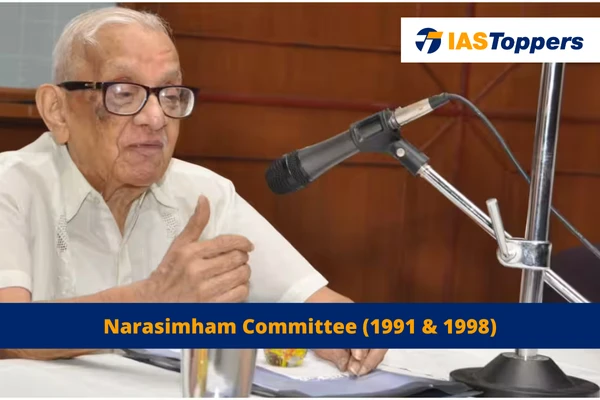India’s remarkable economic growth from the 1991 crisis to becoming the world’s third-largest economy in 2011 brought about significant changes in its banking sector. The Finance Ministry of the Government of India established expert committees, including the renowned Narasimham Committee I & II, to enhance the effectiveness, competitiveness, and efficiency of the banking industry.
Narasimham Committee I and II (CMBs) will be helpful for UPSC IAS Exam preparation. GS Paper-3 Indian Economy.
Table of Content
- Narasimham Committee I
- Recommendations of Narasimham Committee I
- Narasimham Committee II
- Recommendations of Narasimham Committee II, 1998
- Conclusion
- Frequently Asked Questions (FAQs)
Narasimham Committee I
- Formation: In August 1991, the government established a Narasimham Committee on Financial System (CFS) chaired by M. Narasimham.
- The committee was tasked with examining various aspects of the financial system, including its structure, organization, functions, and procedures.
- Objective of Recommendations: The recommendations put forth by the Narasimham Committee aimed to achieve the following objectives:
- Operational Flexibility: Enhancing the operational flexibility of banks.
- Internal Autonomy: Granting public sector banks (PSBs) internal autonomy in their decision-making processes.
- Professionalism: Promoting professionalism in banking operations.
Recommendations of Narasimham Committee I
Recommendations on Banking
- Strengthen and transform banking supervision to shift focus from intense micro-intervention in credit decisions to prudential regulation.
- These recommendations were accepted by the government, and guidelines were issued in April 1992 through the RBI, covering income recognition, asset classification, provisioning, and adopting Basel capital adequacy standards.
- Four-tier hierarchy: Establish a four-tier hierarchy for the banking structure, with three or four large banks, including the State Bank of India at the top.
- Rural banks at the bottom, primarily involved in financing agriculture and related activities.
- Delegate supervisory functions over banks and financial institutions to a separate quasi-autonomous body supported by the Reserve Bank of India.
- Gradually achieve an eight per cent capital adequacy ratio, as suggested by the Basel committee, in a phased manner.
- Eliminate the branch licensing policy.
Recommendations on RBI:
- Implement a gradual reduction in the statutory liquidity ratio from 1991-92.
- Deregulate interest rates that are linked to the bank rate, based on the guidelines provided by the Chakravarty Committee.
- Encourage competition among financial institutions, fostering a syndicating or participating approach rather than a consortium approach.
- Restructure the Industrial Development Bank of India, limiting its role to refinancing and assigning its direct lending activities to a separate corporate entity.
Recommendations on NPA:
- Enforce prudential guidelines to govern the operations of financial institutions.
- Ensure accurate classification of assets and promote full disclosure and transparency in the accounts of banks and other financial institutions.
- Establish an Asset Reconstruction Fund (ARF) to facilitate banks in transferring their bad assets at a discount or book value.
Other Recommendations:
- Allow interest rates to increasingly fulfil their primary function of allocating limited loanable funds among different users.
- To enable this, rates should broadly be determined by market forces.
- Phase out the directed credit program.
Narasimham Committee II
- Formation: In December 1997, the government established a new committee chaired by M. Narasimham to address banking sector reforms.
- Report Submission: April 1998.
- Objective: to assess the progress of banking sector reforms and propose a program for financial sector reforms to enhance India’s financial system and its competitiveness on the global stage.
Recommendations of Narasimham Committee II, 1998
Strengthening the banking system
- To enhance international trade, the Committee suggested merging major public sector banks. However, caution was given against combining stronger banks with weaker ones.
Narrow Banking
- Some public sector banks faced the issue of high non-performing assets (NPAs).
- To successfully rehabilitate such banks, the Committee recommended the concept of Narrow Banking.
- This allowed banks to invest their funds in short-term and low-risk assets.
Reforms in RBI’s role
- The Committee proposed reforms in the role of the RBI within the banking sector.
- It is believed that as the regulator, the RBI should not have ownership in any bank.
Government ownership
- The Committee suggested reviewing government ownership of banks.
- It highlighted that such ownership hampers bank autonomy, leading to mismanagement.
Addressing NPAs
- The Committee aimed to reduce banks’ NPAs to 3% by 2002.
- It also recommended establishing Asset Reconstruction Funds or Companies.
- These recommendations resulted in the introduction of the Securitisation and Reconstruction of Financial Assets and Enforcement of Security Interest Act, 2002.
Capital Adequacy Ratio
- The Committee proposed increasing the government’s Capital Adequacy Ratio norms.
Foreign banks
- It also suggested raising the minimum start-up capital for foreign banks from $10 million to $25 million.
Conclusion
The influential Narasimham Committee-I (1991) and Narasimham Committee-II (1998) reports provided pivotal recommendations that not only unlocked the potential of India’s banking sector but also played a role in safeguarding it from the global financial crisis of 2007. As India embraced globalization, the resilience of its banks during the 2008 financial crisis can be attributed, in part, to the invaluable contributions of the Narasimham Committees.
Ref: Source-1
| Other Articles in Economy | |
| Participatory Notes | Aviation Industry in India |
| National Income of India | Securities and Exchange Board of India (SEBI) |
| Privatization of Government Sector | Electoral Bonds |
FAQs (Frequently Asked Questions)
What was the Narasimham Committee established for?
The government of India appointed a nine-member team called the Narasimham Committee I to analyze India’s banking sector and recommend reforms.
Who is known as the father of banking reforms in India?
Maidavolu Narasimham, the chairman of Narsimhan Committees I & II is also known as the father of banking reforms in India.
Which committee recommended setting up RRB?
Narasimham committee recommended the establishment of Regional Rural Banks in India.



